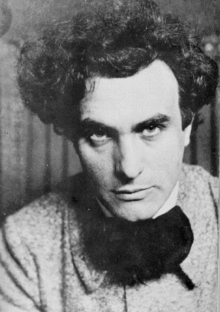Arcana (Varèse)
Arcana is a symphonic poem for large orchestra by French composer Edgard Varèse. It was composed between 1925 and 1927, with a later revision in 1931–32.
| Arcana | |
|---|---|
| by Edgard Varèse | |
 Edgard Varèse | |
| Catalogue | IEV 2 |
| Period | Contemporary music |
| Form | Symphonic poem |
| Composed | 1927 (rev. 1932) |
| Performed | 8 April 1927: Academy of Music, Philadelphia |
| Published | 1931 (rev. version 1964) |
| Publisher | Max Eschig Colfranc Ricordi |
| Duration | 16 minutes |
| Scoring | Orchestra |
Background
As stated in letters to his wife in New York, Varèse first conceived a few motifs that would later be used in Arcana in a dream on 9 October 1925, while on a visit to Île Saint-Louis.[1] He originally intended for it to be ready for early 1926, as Leopold Stokowski was ready to include it in a program at Carnegie Hall. However, the complicated musical language used in Arcana forced him to postpone its premiere to 1927.[2]
Its title, Arcana, as explained in his letter, refers to the mysteries of alchemy. Varèse includes a quote from Paracelsus's Hermetic Astronomy. Varèse explored the realm of dreams with the musical language present in Arcana, since he believe that the birth of art came from the unconscious and not from reason.[3]
One star exists, higher than all the rest. This is the apocalyptic star. The second star is that of the ascendant. The third star is that of the elements—of these there are four, so that six stars are established. Besides these there is still another star, imagination, which begets a new star and a new heaven.
— Paracelsus, Hermetic Astronomy
The first performance took place on 8 April 1927, at the Academy of Music in Philadelphia, with the Philadelphia Orchestra conducted by Leopold Stokowski. It was then published by Max Eschig in 1931. On the occasion of the French premiere, Varèse revised the piece again in 1932. The revised version was premiered by Nicolas Slonimsky on 25 February 1932, in Paris. The revised version was published one year before Varèse's death, in 1964, by Colfranc. It has been available under Ricordi since the year 2000.[4]
Structure
Often described as a passacaglia,[5][1] Arcana is a sixteen-minute symphonic poem in one movement scored for a large orchestra. It is scored for three piccolos, two flutes, three oboes, one English horn, one heckelphone, two clarinets in E-flat, two clarinets in B-flat, one bass clarinet, three bassoons, two contrabassoons, eight horns in F, five trumpets in C, two tenor trombones, one bass trombone, one contrabass trombone, one tuba, one contrabass tuba, sixteen first violins, sixteen second violins, fourteen violas, twelve violoncellos, ten double basses, six pedal timpani and six additional percussionists.[6]
The percussion scoring is particularly large, as in most other pieces for orchestra by Varèse.
- Percussionist I plays a medium-sized gong, a Chinese cymbal (or a crash cymbal), a high tam-tam, a bass drum, and a triangle.
- Percussionist II plays a low tam-tam, a slap stick, a bass drum, a triangle, and a tambourine.
- Percussionist III plays a snare drum, a guiro, a triangle, and two Chinese blocks (high and low with drumsticks).
- Percussionist IV plays a side drum, a tambourine, and a suspended cymbal (with drumsticks)
- Percussionist V plays cymbals, a string drum (also called a lion's roar, a single-headed drum with a piece of heavy twine attached to the center of the membrane), and two coconuts (hollow cylinders of wood, 2 inches in height and 2½ in diameter, covered at one end, one in each hand, to be played by striking the open ends of the instruments against a wooden board covered with felt).
- Percussionist VI plays a xylophone, a glockenspiel, two Chinese blocks (high and low with metal sticks), a rattle, a tambourine, a guiro, cymbals, a triangle, and three bells.
Some percussionists are required to trade places along the piece to play specific instruments from other performers.[6]
References
- Tual, François-Gildas. "Edgard Varèse: Arcana, performed by the Orchestre National de France, conducted by Pascal Rophé". France Musique. Retrieved 1 December 2020.
- Bernard, Jonathan W. (14 November 1992). "Edgard Varése's "Arcana"". American Symphony Orchestra. Retrieved 1 December 2020.
- Quinn, Peter. "VARESE: Orchestral Works, Vol. 1 - Arcana / Integrales / Deserts". www.naxos.com. Retrieved 1 December 2020.
- "Arcana, Edgard Varèse". brahms.ircam.fr. Retrieved 1 December 2020.
- Mancini, Donato. "Arcana, for orchestra | Details". AllMusic. Retrieved 1 December 2020.
- Varèse, Edgard (2010). Arcana, for Orchestra - Full Score - 135311. San Giuliano Milanese: Ricordi. p. III - V. ISMN 9790041353111. Retrieved 6 December 2020.
External links
- Arcana: Scores at the International Music Score Library Project